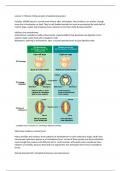Phylum molluscs - Study guides, Class notes & Summaries
Looking for the best study guides, study notes and summaries about Phylum molluscs? On this page you'll find 12 study documents about Phylum molluscs.
All 12 results
Sort by
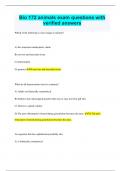
-
Bio 172 animals exam questions with verified answers
- Exam (elaborations) • 19 pages • 2024
- Available in package deal
-
- $9.99
- + learn more
Bio 172 animals exam questions with verified answers Which of the following is (are) unique to animals? A) the structural carbohydrate, chitin B) nervous and muscular tissue C) heterotrophy D) gametes B) nervous and muscular tissue What do all deuterostomes have in common? A) Adults are bilaterally symmetrical. B) Embryos have pharyngeal pouches that may or may not form gill slits. C) All have a spinal column. D) The pore (blastopore) formed during gastrulation becomes the anu...
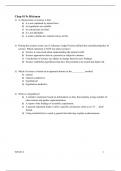
-
Test Bank for Animal Diversity, 9th Edition by Cleveland Hickman
- Exam (elaborations) • 272 pages • 2023
-
- $29.49
- + learn more
Test Bank for Animal Diversity, 9th Edition 9e by Cleveland Hickman, Jr., Susan Keen, Allan Larson, David Eisenhour and Larry Roberts. ISBN-13: 0887 Full Chapters test banks are included 1. Science of Zoology and Evolution of Animal Diversity 2. Animal Ecology 3. Animal Architecture 4. Taxonomy and Phylogeny of Animals 5. Unicellular Eukaryotes 6. Sponges: Phylum Porifera 7. Cnidarians and Ctenophores 8. Xenacoelomorpha, Platyhelminthes,Gastrotricha, Gnathifera, including Chaetognat...
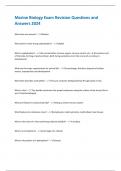
-
Marine Biology Exam Revision Questions and Answers 2024
- Exam (elaborations) • 2 pages • 2024
-
- $3.49
- + learn more
What class are mussels? - Bivalvia What doesn't show strong cephalization? - Jellyfish What is cephalization? - the concentration of sense organs, nervous control, etc., at the anterior end of the body, forming a head and brain, both during evolution and in the course of an embryo's development. What are the major requirements for animal life? - Gas exchange, Nutrition, disposal of cellular wastes, reproduction and development What best describes comb jellies? - They are creatures di...
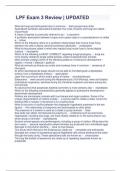
-
LPF Exam 3 Review | UPDATED
- Exam (elaborations) • 2 pages • 2023
-
- $8.99
- + learn more
LPF Exam 3 Review | UPDATED What do fungi and arthropods have in common - both groups have chitin Specialized symbiotic associations between the roots of plants and fungi are called - mycorrhizae A mass of hyphae is commonly referred to as - a mycelium A symbiotic association between fungus and a green alga or a cyanobacterium is called a - lichen Which of the following refers to a symbiotic relationships that involve fungi living between the cells in plants (several synthesize al...
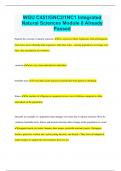
-
WGU C451/GNC2/1NC1 Integrated Natural Sciences Module 8 Already Passed
- Exam (elaborations) • 10 pages • 2023
-
Available in package deal
-
- $9.99
- + learn more
WGU C451/GNC2/1NC1 Integrated Natural Sciences Module 8 Already Passed Explain the concept of natural selection. It is a process where organisms with advantageous traits leave more offspring than organisms with other traits - causing populations to change over time. (key mechanism of evolution) variation traits vary from individual to individual heritable traits A trait that can be passed on genetically from parent to offspring. fitness the number of offspring an organism leaves over its life...
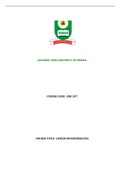
-
BIO 207
- Class notes • 69 pages • 2022
-
- $14.99
- + learn more
NATIONAL OPEN UNIVERSITY OF NIGERIA COURSE CODE : BIO 207 COURSE TITLE: LOWER INVERTEBRATES Course Code & Course Title: BIO 207: Lower Invertebrates Course Writer: Dr. Patrick A. Audu Course Editor Programme Leader Dr. Ado Baba Ahmed National Open University of Nigeria, Lagos Course Coordinator Mr. Adams, Abiodun E National Open Univers...
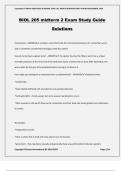
-
BIOL 205 midterm 2 Exam Study Guide Solutions
- Exam (elaborations) • 24 pages • 2024
-
- $12.49
- + learn more
BIOL 205 midterm 2 Exam Study Guide Solutions rhynchocoel - ANSWER-a tubular cavity that holds the introverted proboscis of a nemertean worm and is sometimes considered homologous with the coelom how do nemerteans capture prey? - ANSWER-To capture its prey, the ribbon worm has a unique eversible proboscis at the front end of the body that injects a venom into its prey. After injecting it, the worm waits for the prey to be paralysed before moving in to feed on it. how might you distinguish...
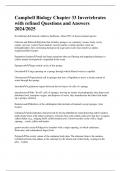
-
Exam (elaborations) Biology
- Exam (elaborations) • 8 pages • 2024
-
- $7.99
- + learn more
Invertebrates️️Animals without a backbone. About 95% of known animal species. Calcarea and Silicea️️phylum that includes sponges; no symmetry, tissues, body cavity, organs, nervous system; basal animals; mostly marine; contain spicules; most are hermaphrodites; free-swimming during larval stage and sessile (non motile) as adults; suspension/filter feeders Suspention feeders️️small and large organisms that use filtering and trapping techniques to collect minute food particles su...
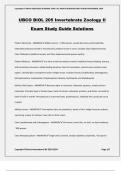
-
UBCO BIOL 205 Invertebrate Zoology II Exam Study Guide Solutions
- Exam (elaborations) • 6 pages • 2024
-
- $11.49
- + learn more
UBCO BIOL 205 Invertebrate Zoology II Exam Study Guide Solutions Phylum Nemertea - ANSWER-Ribbon worms. ~1200 species, usually dioecious, protonephridia, extensible proboscis (stored in rhynchocoel), pilidium larvae in some. Includes Class Palaeonemerata, Class Pilidiophora (pilidium larvae), and Class Hoplonemerata (posess stylets) Phylum Mollusca - ANSWER-Can have a shell secreted by mantle, head/foot houses feeding, sensory, and locomotive structures, radula feeding structure, foot for ...
Lecture notes from the first year about molluscs (part of Bilaterians, Molluscs and Arthropods)

How did he do that? By selling his study resources on Stuvia. Try it yourself! Discover all about earning on Stuvia



